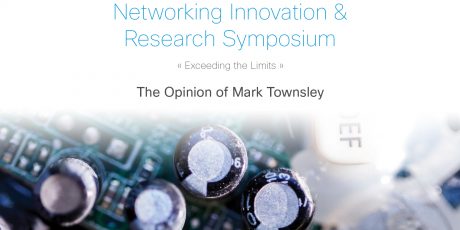
[Symposium 2017 – #2] The Future of Infrastructures: The Opinion of Mark Townsley

Sponsored article – Author: Pierre Guyot, Editor, Usbek & Rica
The symposium “New Generation of Networking Innovation and Research” Cisco – École Polytechnique 2017
 3 questions to Mark Townsley, Cisco engineer and co-founder of Paris Innovation and Research Lab (PIRL)
3 questions to Mark Townsley, Cisco engineer and co-founder of Paris Innovation and Research Lab (PIRL)
How are tomorrow’s networks taking shape ?
The new IPv6-centric architectures are making the most out of the enormous infrastructure that is being rolled out on a large scale centered on the IPv6 protocol. This creates many new possibilities relating to the Internet such as we know it today. The largest data center operators, but also telecoms operators and several large companies (we have seen it here with the presentations of Microsoft and JP Morgan), have seized upon IPv6. All this illustrates to what point a new paradigm is being created, and this on a global scale, network after network. We are at the point today of capitalizing on something whose rollout began several years ago, and which allows us to simplify, to create economies of scale, and to create new functionalities. The discussions show it: we are very advanced in this arena but, at the same time, we should be realistic concerning the challenges that are still in store for the industry.
In conjunction with this, I am very happy to see the emergence of ICN, Information-Centric Networking, with several effective and very innovative demonstrations that process data directly on the network without passing through the traditional overlaid Content Delivery Networks (CDN). A page has been turned with an infrastructure completely centered on information: here again, it is both a domain for research and nonetheless proved by the technologies that are being implemented.
In the space of a year, have these technologies greatly evolved?
The first PIRL symposium had already evoked ICN and IPv6-centric networking, but these technologies were clearly at a beginning stage of development. On segment routing, for example, which permits great operational simplicity, flexibility, and optimized network scalability, we were then more in reflection mode. Today, it is real. For ICN, we see that the problems taken up are more precise; this is a sign of advancement.
What other subjects seem central to you for the Internet of tomorrow?
The focus that we have made on audiovisual production shows that we are in the midst of profound technological changes, for example concerning virtual environments. It is interesting to hear certain industrialists in this field show how far we have gone and the challenges that remain to be taken up, and to see certain laboratory researchers answer them by saying that we can solve such a problem in such a way.
It is evident that when we speak of IPv6-centric networking or Information-Centric Networking (ICN), it is a question of creating a large interconnection where the networks become the infrastructure and an infrastructure that, moreover, is intelligent and in perfect compatibility with the content and information that it delivers. It is not by chance that many connections made between the participants in the symposium are also made in our session dedicated to artificial intelligence.
Why a symposium?
In a period marked by decisive mutations for the future of Internet protocols, the symposium aims to combine different avant-garde points of view, furthering the meeting between the academic and industrial worlds. It is as much a moment of sharing expertise through about 30 presentations, as an opportunity for human networking left and right—with one marching order: meet someone that one would have never met otherwise.
What is PIRL?
The Paris Innovation and Research Lab is the largest Cisco technological engineering laboratory in Europe. It comprises a team made up of a Cisco Fellow, five Distinguished Engineers (or Lead Engineers), around thirty software, systems and research engineers, and about twenty researchers, PhD’s and students. Also, to operate and do research efficiently, we have incorporated at our side a vast research ecosystem with several university chairs and partnerships as well as public-private research organisms. The PIRL is also an organism helping start-ups, dedicated to the co-creation and the acceleration of innovative projects.
Relive the symposium now by looking at our playlist.
Find all the symposium articles on our blog:
- The Future of Infrastructures: Exceeding the Limits
- Information-Centric Networking: the Infrastructure of Tomorrow?
- Artificial Intelligence: its Impact on Networking
- Media Production Makes its Transformation to IP
- IPv6-centric Networking, a Crucial Rollout for Tomorrow
- architecture
- CDN
- content delivery networks
- ICN
- information centric networking
- infrastructure
- Innovation
- IPV6
- Mark Townsley
- network
- pirl
- Research
- symposium



